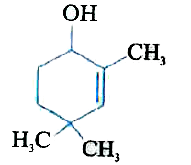Describe the acton of aqueous KOH (or NaOH) on isopropyl bromide
To describe the action of aqueous KOH (or NaOH) on isopropyl bromide, we can follow these steps:
1. Identify the Reactants:
- The reactant is isopropyl bromide, which has the structure C3H7Br or (CH3)2CHOBr (isopropyl group attached to bromine).
- The reagent is aqueous KOH (or NaOH), providing hydroxide ions (OH−).
2. Mechanism of Reaction:
- Isopropyl bromide is a secondary alkyl halide. When it reacts with aqueous KOH, the hydroxide ion acts as a nucleophile.
- The bromine atom in isopropyl bromide is a good leaving group. The OH− will attack the carbon atom that is bonded to the bromine.
3. Nucleophilic Substitution:
- The mechanism involved here is the SN2 (bimolecular nucleophilic substitution) mechanism. The nucleophile (OH−) attacks the electrophilic carbon (the carbon attached to bromine), leading to the formation of an alcohol.
- The reaction can be represented as:
(CH3)2CHOBr+OH−→(CH3)2CHOH+Br−
- Here, the bromine ion (Br−) leaves, resulting in the formation of isopropyl alcohol ((CH3)2CHOH).
4. Products:
- The major product of the reaction is isopropyl alcohol ((CH3)2CHOH).
- The side product formed is potassium bromide (KBr).
5. Final Reaction Equation:
- The overall reaction can be summarized as:
(CH3)2CHOBr+KOH→(CH3)2CHOH+KBr
Summary of the Reaction:
- Isopropyl bromide reacts with aqueous KOH to undergo nucleophilic substitution, resulting in the formation of isopropyl alcohol and potassium bromide.
- The reactant is isopropyl bromide, which has the structure C3H7Br or (CH3)2CHOBr (isopropyl group attached to bromine).
- The reagent is aqueous KOH (or NaOH), providing hydroxide ions (OH−).
- Isopropyl bromide is a secondary alkyl halide. When it reacts with aqueous KOH, the hydroxide ion acts as a nucleophile.
- The bromine atom in isopropyl bromide is a good leaving group. The OH− will attack the carbon atom that is bonded to the bromine.
- The mechanism involved here is the SN2 (bimolecular nucleophilic substitution) mechanism. The nucleophile (OH−) attacks the electrophilic carbon (the carbon attached to bromine), leading to the formation of an alcohol.
- The reaction can be represented as:
(CH3)2CHOBr+OH−→(CH3)2CHOH+Br−
- Here, the bromine ion (Br−) leaves, resulting in the formation of isopropyl alcohol ((CH3)2CHOH).
- The major product of the reaction is isopropyl alcohol ((CH3)2CHOH).
- The side product formed is potassium bromide (KBr).
- The overall reaction can be summarized as:
(CH3)2CHOBr+KOH→(CH3)2CHOH+KBr
- Isopropyl bromide reacts with aqueous KOH to undergo nucleophilic substitution, resulting in the formation of isopropyl alcohol and potassium bromide.
Similar Questions
Knowledge Check
 on treatment with aqueous KOHA
on treatment with aqueous KOHA B
B C
C D
D
Arrange the following alkyl chlorides in order of decreasing reactivity in an SN1 reaction : (I) isopropyl bromide , (II) propyl bromide
(III) tert-butyl bromide , (IV) methyl bromideA(III)>(I)>(II)>(IV)B(I)>(III)>(IV)>(II)C(IV)>(III)>(II)>(I)D(I)>(II)>(III)>(IV)Assertion: In the reaction of tert-butyl bromide with aq. KOH, rate becomes double by increasing the concentration of both aq. KOH and tert-butyl bromide
Reason: Rate of reaction is, rate = kſtert butyl bromide) [OH−].AAssertion and reason both are correct statements and reason is correct explanation for assertion.BAssertion and reason both are correct statements but reason is not correct explanation for assertion.CAssertion is correct statement but reason is wrong statement.DAssertion is wrong statement but reason is correct statement.
Describe the action of excess of ammonia on n-propyl bromide.
View SolutionDescribe the action of AgCN on ethyl bromide.
View SolutionHow will you bring about the following conversions
(i) Propene into Isopropyl bromide
(ii) Propene into n-propyl bromide.
View SolutionExplain , the mechanism of alkaline hydrolysis (reaction with aqueous KOH) of tert-butyl bromide (2-Bromo-2- methyl - propane ) with energy profile diagram.
View SolutionAssertion: In the reaction of tert-butyl bromide with aq. KOH, rate becomes double by increasing the concentration of both aq. KOH and tert-butyl bromide
Reason: Rate of reaction is, rate = kſtert butyl bromide) [OH−].
View Solution
